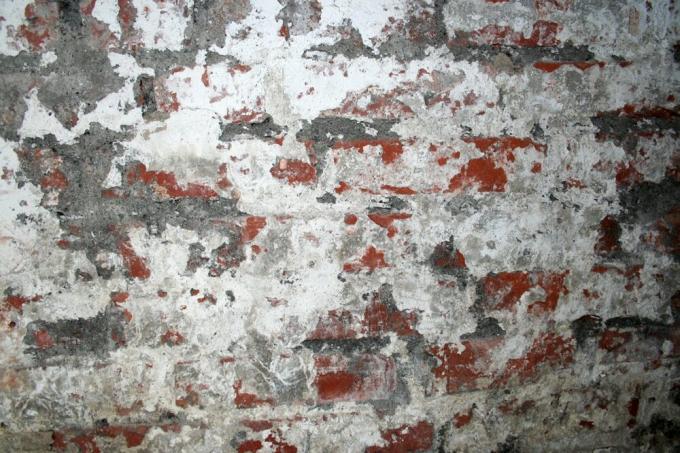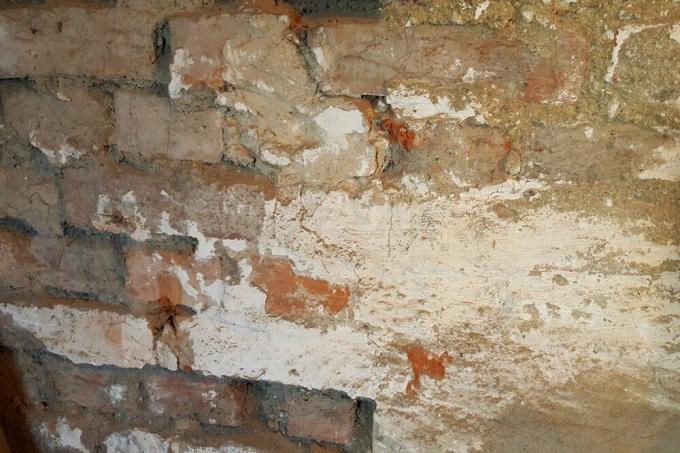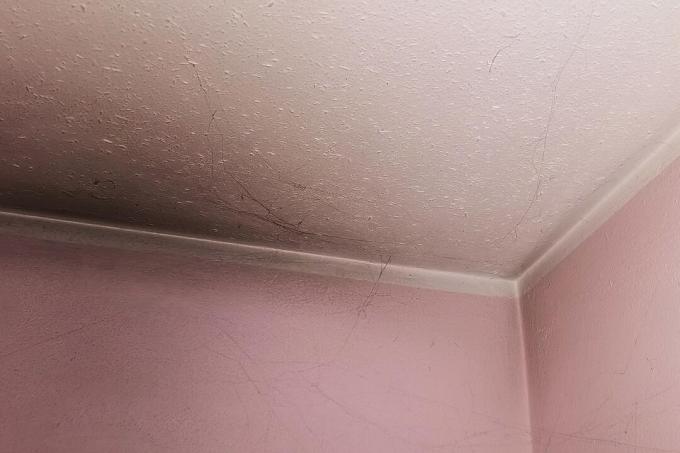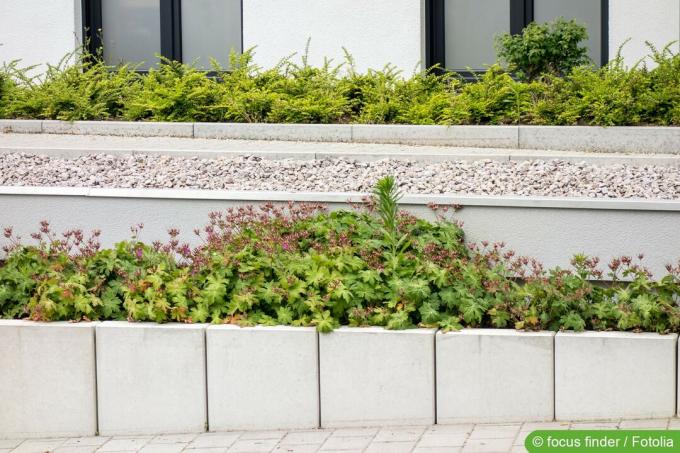

Table of contents
- Saltpetre in the masonry
- Clearly identify saltpetre
- Identify the causes of the saltpetre infestation
- Remove smaller deposits manually
- Manual removal with a brush
- Remove saltpeter with cola
- Use a chemical remover
Saltpeter is a salt that can form in damp masonry. Once saltpetre is established, it will not go away on its own. It should be removed because the masonry can become damaged over the years. The salts in combination with the permanent moisture decompose the masonry. First the plaster crumbles, later it can become unstable.
Saltpetre in the masonry
– Basics of the problem –
Saltpetre can be recognized by discoloration of the masonry inside or outside. White to yellowish shades indicate that it could be saltpetre. First of all, the places concerned are very small. However, they will increase over time as the moisture in the masonry rises. It is important that you take countermeasures quickly. The earlier you start, the more effective you are at preventing damage to masonry. There are various measures for the removal of saltpetre. However, before you settle on any of the options, it's important that you find out if it's saltpeter in the first place. Saltpetre is easily confused with mold in masonry, for which other removal measures apply.
Clearly identify saltpetre
How can you tell saltpetre from mold? At first glance, this is often not that easy. Saltpetre, also known as salt efflorescence, often looks a lot like mold on a wall. Both variants can occur both outdoors and indoors.
Scratch test from the wall as a simple remedy
You can positively identify saltpeter by scratching the wall. Use a small spatula or a wide screwdriver for this. It is advisable if you wear gloves. Carefully remove part of the siege, trying not to drop anything on the ground.
Let the scratch sample dry out

Place the scratch sample on a flat surface, such as a wooden or plastic board. After just one day, the drying process will have started on the small amount. Now you can tell salt efflorescence from mold very well. Salt efflorescence will crystallize after drying. You can see the small crystals with the naked eye. If it is mold, you will find a greasy mass without coarse grains on the smooth surface. If you look closely, you might also notice on the wall that saltpeter has a rather dry and granular consistency. In most cases, however, the scratch test provides information and you can rely on the result.
Good to know:
In contrast to mould, saltpetre has a dry, granular consistency and looks a little lighter and glassier on the wall.
Identify the causes of the saltpetre infestation
Before you start removing the salt efflorescence, it is important that you determine the causes. Otherwise, you will face the problem again and again. If you have managed to remove the saltpeter effectively, it can appear again after a short time if you do not take care of the causes at the same time.
Eliminate moisture in the walls
Moisture in the wall is one of the conditions from which saltpeter can develop in the first place. It is important that you eliminate the cause of the moisture build-up. In many cases you don't need to do much more than change the interaction between heating and ventilation. Regular airing is also very important in winter to remove moisture from the masonry. This is especially true on days that are very cool and wet and when you don't want to open the window at all. The warm heating air dries the masonry from the inside. Make sure that you also lightly heat the rooms in which you do not spend all the time. A false compulsion to save can have a negative effect on the masonry.
Detect and repair cracks in the outer wall
In older houses there are often cracks in the plaster or in the outer wall. Leaks in windows and doors can also cause moisture to spread through the masonry. Also, check your plumbing. A small leak that constantly releases water droplets into the masonry can be enough to allow moisture to build up in the wall. As a result, saltpeter can form. If you manage to get the moisture out of the wall, no new salt efflorescence can form and you have permanently solved the problem.
Extra tip:
Check the masonry regularly for moisture and get to the bottom of the cause straight away. In this way, you can specifically prevent the formation of saltpeter without having to spend a lot of money on cleaning up.
Remove smaller deposits manually
If you identify small amounts of salt efflorescence on your masonry, you can remove it manually. Use a spatula for this. Lift the saltpeter off the masonry. It may then be necessary to smooth the masonry. After you have analyzed where the moisture is coming from, take care of draining the damp spot. After that, the problem should be resolved.
Danger:
Manual removal is only suitable for very small deposits, as otherwise it would require too much effort to remove.
Manual removal with a brush
Larger deposits can be removed with a hard brush. A classic hand brush is suitable for this, which you should buy new for this purpose. Since the debris will fall to the ground and it is a salt, it is recommended that you wear shoes even on warm days. Put on protective clothing and possibly wear a face mask. Now brush the masonry so vigorously that the deposits are loosened from the wall.
Danger:
Don't leave any residue in the wall.
It is important that you take great care to remove all deposits. Otherwise, the saltpetre can rebuild from the remnants and spread again.
After brushing off any residue, remove it from the floor. Use a classic broom for this or, if possible, a powerful industrial vacuum cleaner. Under no circumstances should you use your household vacuum cleaner, because you could spread small residues in the apartment or house.
Important to know:
There may already be mold in the deposits, which you can inhale under certain circumstances when removing large areas with a brush. If you are allergic, wearing a respiratory mask is mandatory.
Remove saltpeter with cola

A home remedy that has proven effective in removing saltpetre is the classic cola. You can buy inexpensive drinks from the supermarket or discounter and do not need to resort to expensive branded products.
Danger:
Use sugary cola and no diet products.
The composition of the sugary cola means that the saltpeter can easily detach from the wall. Apply the cola to the affected areas with a paint roller, a stiff sponge or a wide brush. The wall should be dry. If this is not the case, switch to another option, because you should only use Cola on dry areas of the wall. The cola should not soak in for more than ten minutes.
Wipe saltpeter off the wall
When the cola has spread on the wall, you can simply wipe off the saltpetre. Pay attention to your health and wear a face mask if necessary.
Since it's a food item, it's important that you do a really good job of removing the leftovers from the cola from the wall. Otherwise they offer a very good breeding ground for bugs, which are mainly attracted to the sugar. Coke is an inexpensive way to remove saltpeter. The measure is also suitable for larger areas.
Extra tip:
For further processing of the wall, use a brush to really remove all deposits.
Use a chemical remover
Removing the saltpetre with a chemical agent is very effective and requires little effort. However, this method is only suitable for areas that are not extensively affected. You can get saltpeter remover in the hardware store or in the building materials trade.
Danger:
Purchase a sufficient quantity of the chemical remover and follow the usage instructions on the bottle.
Apply the saltpetre remover to the wall. You have various options for this, which also depend on which bottle you bought. Some bottles are equipped with a spray head and are therefore particularly practical. All you have to do is spray the solution onto the affected areas and let it soak. It is not necessary to remove the solution as it penetrates deep into the masonry and dissolves the salt efflorescence. Alternatively, use a paint roller or a wide brush to apply the solution to the wall.
Important:
The solution cannot damage the masonry. It can also be applied to damp masonry to remove the saltpeter first. The second step should be drying.

The solution can also remove discoloration that may form on the walls. Let the saltpeter remover work for a day or two and then assess the result. If you are not satisfied, you can repeat the application up to twice. Then the deposits are usually gone.
Danger:
The saltpeter remover is not harmful to health and can be used indoors without hesitation.
However, if you use the saltpetre remover indoors, you should keep a few things in mind:
- Rooms should be well ventilated
- avoid a permanent stay in the treated rooms for a period of two days
- not sleeping in the treated room for two to three nights
- Babies and small children should not be in the room
- Move furniture away from the wall for two to three days
In rare cases, very sensitive people can get headaches because the saltpetre remover has a strong odor. If you know that you are sensitive to odors, it may be advisable to wear a face mask during treatment. However, this is not absolutely necessary.
 Home editorial office
Home editorial office
Learn more about wall / wall

Fogging: what to do against black dust on walls?
Fogging is still a foreign concept to many, although black dust on walls, ceilings and carpets has been a widespread problem since the 1990s. We give all the important information about the tiresome topic from the emergence to the fight.

Have L-bricks placed: overview of prices / costs
Making slope fortifications or edging from L-stones is one of the more challenging real estate projects. While you can certainly build smaller fortifications yourself, large amounts of earth should be supported by specialist companies. We explain what to look out for and what costs to expect.

Nails for concrete walls: this is to be considered
In addition to screws and adhesives, the do-it-yourself repertoire also includes nails for the solid assembly and attachment of materials. Not every nail is suitable for every purpose. Choosing the right nail depends on various factors, such as the construction material of the support wall.

Interior plaster: how much plaster do you need per square meter?
If interior plaster is to be applied, one question above all arises: how much plaster do you need per square meter? Because too much material causes unnecessary costs. Too little plaster is annoying because it takes time and money to buy again.

Brick Wall: Remove plaster from bricks
Removing plaster from a brick wall takes effort and careful handling. Bricks are delicate and crack/break easily. Here sensitivity and the right instructions are required, which experts have created for hobby craftsmen and those who want to become one.

Drain house & masonry | Cost & Duration
Anyone who needs to have their house and masonry drained has a choice of different methods. We offer here how the costs can be, how long it can take and other important facts.
